Business Structures, External Environment, and Company Analysis Report
VerifiedAdded on 2023/01/05
|12
|2916
|28
Report
AI Summary
This report provides an in-depth analysis of various business types, including micro, small, medium, and large businesses, with a focus on their characteristics and examples. It explores different organizational structures, such as functional and divisional structures, and examines the influence of the external environment on business structure. The report uses Marks and Spencer as a case study to illustrate these concepts, including an analysis of PESTLE factors (Political, Economic, Social, Technological, Legal, and Environmental) that impact the company's operations. The report covers sole proprietorships, cooperatives, and limited liability partnerships. The report also delves into the characteristics and examples of different business types, along with an assessment of how the external environment affects business structures.
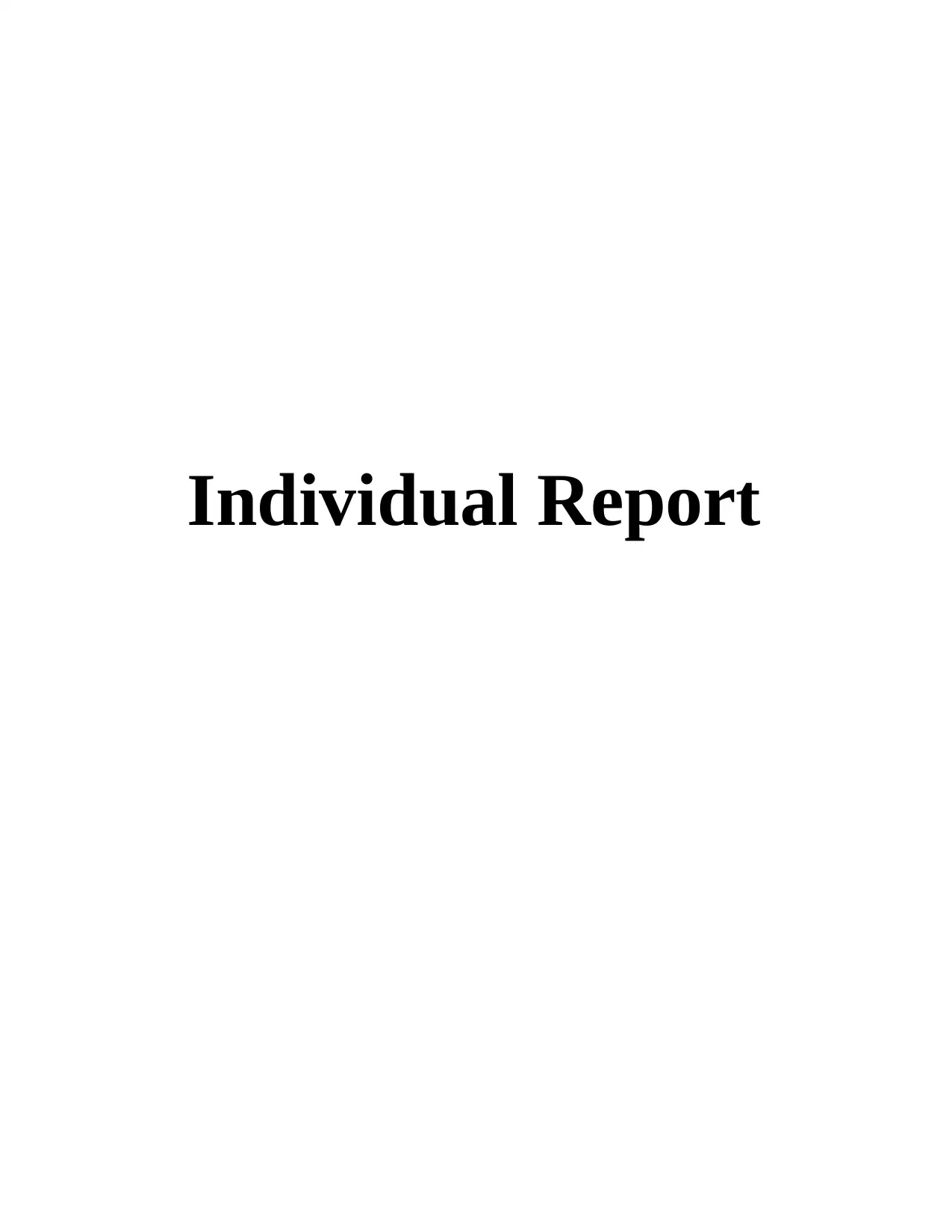
Individual Report
Paraphrase This Document
Need a fresh take? Get an instant paraphrase of this document with our AI Paraphraser
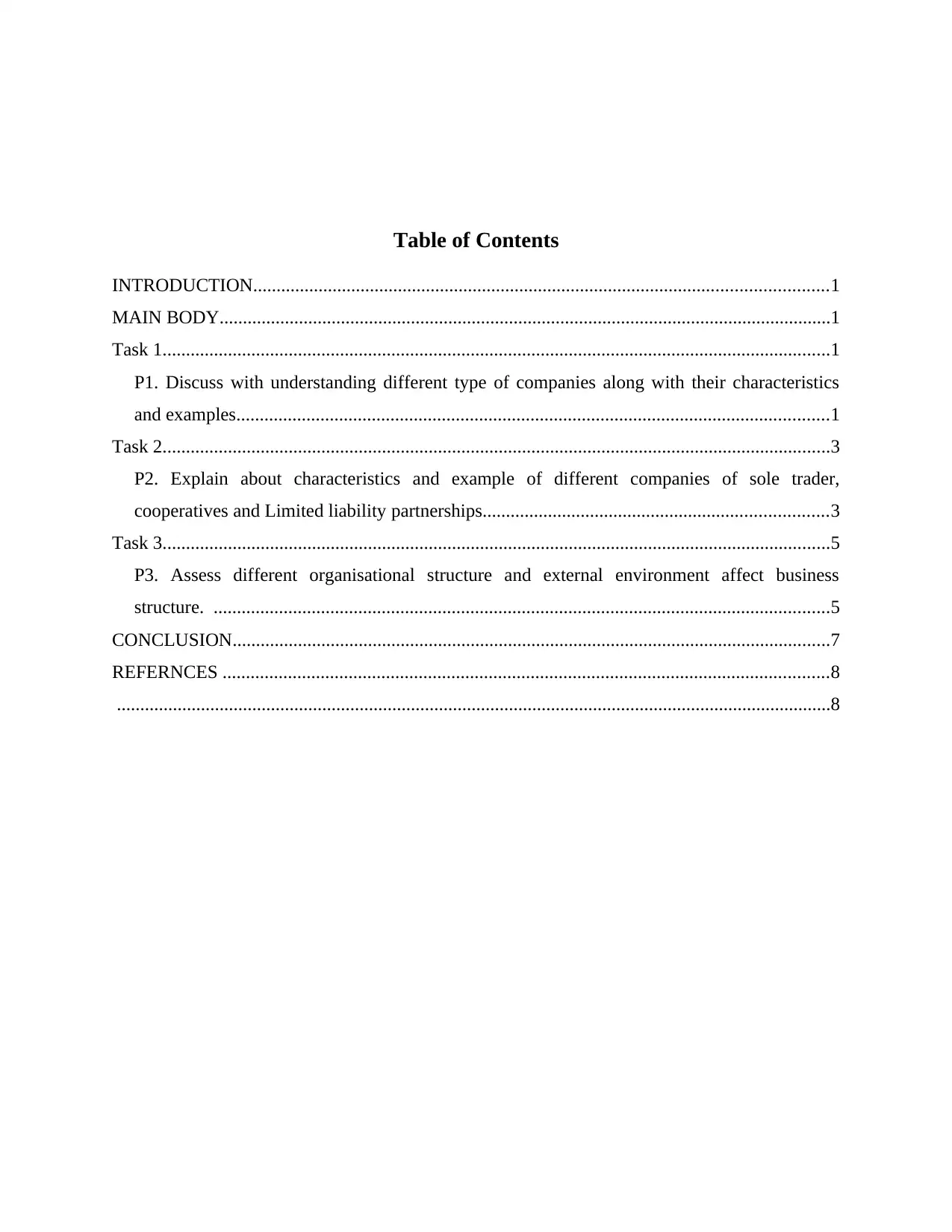
Table of Contents
INTRODUCTION...........................................................................................................................1
MAIN BODY...................................................................................................................................1
Task 1...............................................................................................................................................1
P1. Discuss with understanding different type of companies along with their characteristics
and examples...............................................................................................................................1
Task 2...............................................................................................................................................3
P2. Explain about characteristics and example of different companies of sole trader,
cooperatives and Limited liability partnerships..........................................................................3
Task 3...............................................................................................................................................5
P3. Assess different organisational structure and external environment affect business
structure. ....................................................................................................................................5
CONCLUSION................................................................................................................................7
REFERNCES ..................................................................................................................................8
.........................................................................................................................................................8
INTRODUCTION...........................................................................................................................1
MAIN BODY...................................................................................................................................1
Task 1...............................................................................................................................................1
P1. Discuss with understanding different type of companies along with their characteristics
and examples...............................................................................................................................1
Task 2...............................................................................................................................................3
P2. Explain about characteristics and example of different companies of sole trader,
cooperatives and Limited liability partnerships..........................................................................3
Task 3...............................................................................................................................................5
P3. Assess different organisational structure and external environment affect business
structure. ....................................................................................................................................5
CONCLUSION................................................................................................................................7
REFERNCES ..................................................................................................................................8
.........................................................................................................................................................8

⊘ This is a preview!⊘
Do you want full access?
Subscribe today to unlock all pages.

Trusted by 1+ million students worldwide
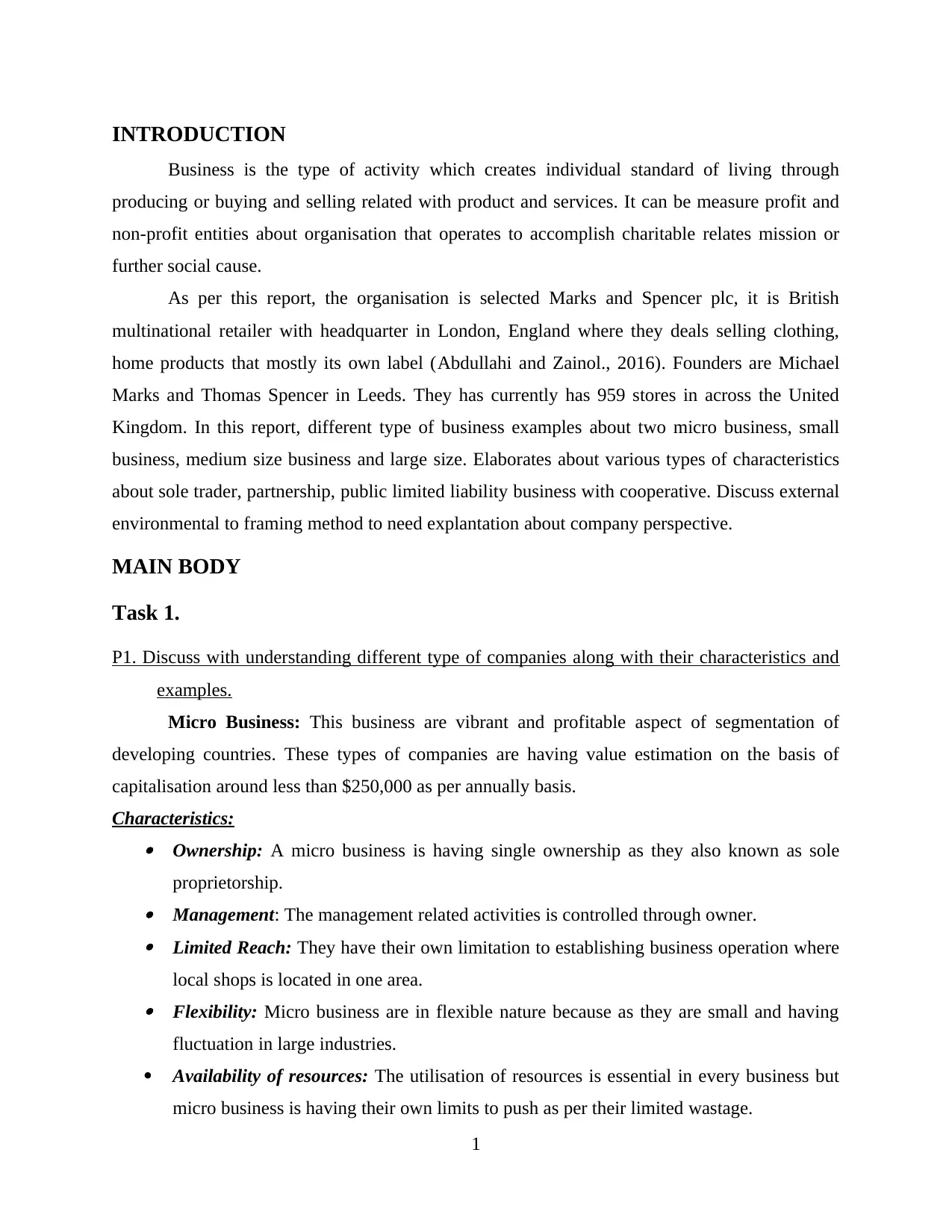
INTRODUCTION
Business is the type of activity which creates individual standard of living through
producing or buying and selling related with product and services. It can be measure profit and
non-profit entities about organisation that operates to accomplish charitable relates mission or
further social cause.
As per this report, the organisation is selected Marks and Spencer plc, it is British
multinational retailer with headquarter in London, England where they deals selling clothing,
home products that mostly its own label (Abdullahi and Zainol., 2016). Founders are Michael
Marks and Thomas Spencer in Leeds. They has currently has 959 stores in across the United
Kingdom. In this report, different type of business examples about two micro business, small
business, medium size business and large size. Elaborates about various types of characteristics
about sole trader, partnership, public limited liability business with cooperative. Discuss external
environmental to framing method to need explantation about company perspective.
MAIN BODY
Task 1.
P1. Discuss with understanding different type of companies along with their characteristics and
examples.
Micro Business: This business are vibrant and profitable aspect of segmentation of
developing countries. These types of companies are having value estimation on the basis of
capitalisation around less than $250,000 as per annually basis.
Characteristics: Ownership: A micro business is having single ownership as they also known as sole
proprietorship. Management: The management related activities is controlled through owner. Limited Reach: They have their own limitation to establishing business operation where
local shops is located in one area. Flexibility: Micro business are in flexible nature because as they are small and having
fluctuation in large industries.
Availability of resources: The utilisation of resources is essential in every business but
micro business is having their own limits to push as per their limited wastage.
1
Business is the type of activity which creates individual standard of living through
producing or buying and selling related with product and services. It can be measure profit and
non-profit entities about organisation that operates to accomplish charitable relates mission or
further social cause.
As per this report, the organisation is selected Marks and Spencer plc, it is British
multinational retailer with headquarter in London, England where they deals selling clothing,
home products that mostly its own label (Abdullahi and Zainol., 2016). Founders are Michael
Marks and Thomas Spencer in Leeds. They has currently has 959 stores in across the United
Kingdom. In this report, different type of business examples about two micro business, small
business, medium size business and large size. Elaborates about various types of characteristics
about sole trader, partnership, public limited liability business with cooperative. Discuss external
environmental to framing method to need explantation about company perspective.
MAIN BODY
Task 1.
P1. Discuss with understanding different type of companies along with their characteristics and
examples.
Micro Business: This business are vibrant and profitable aspect of segmentation of
developing countries. These types of companies are having value estimation on the basis of
capitalisation around less than $250,000 as per annually basis.
Characteristics: Ownership: A micro business is having single ownership as they also known as sole
proprietorship. Management: The management related activities is controlled through owner. Limited Reach: They have their own limitation to establishing business operation where
local shops is located in one area. Flexibility: Micro business are in flexible nature because as they are small and having
fluctuation in large industries.
Availability of resources: The utilisation of resources is essential in every business but
micro business is having their own limits to push as per their limited wastage.
1
Paraphrase This Document
Need a fresh take? Get an instant paraphrase of this document with our AI Paraphraser
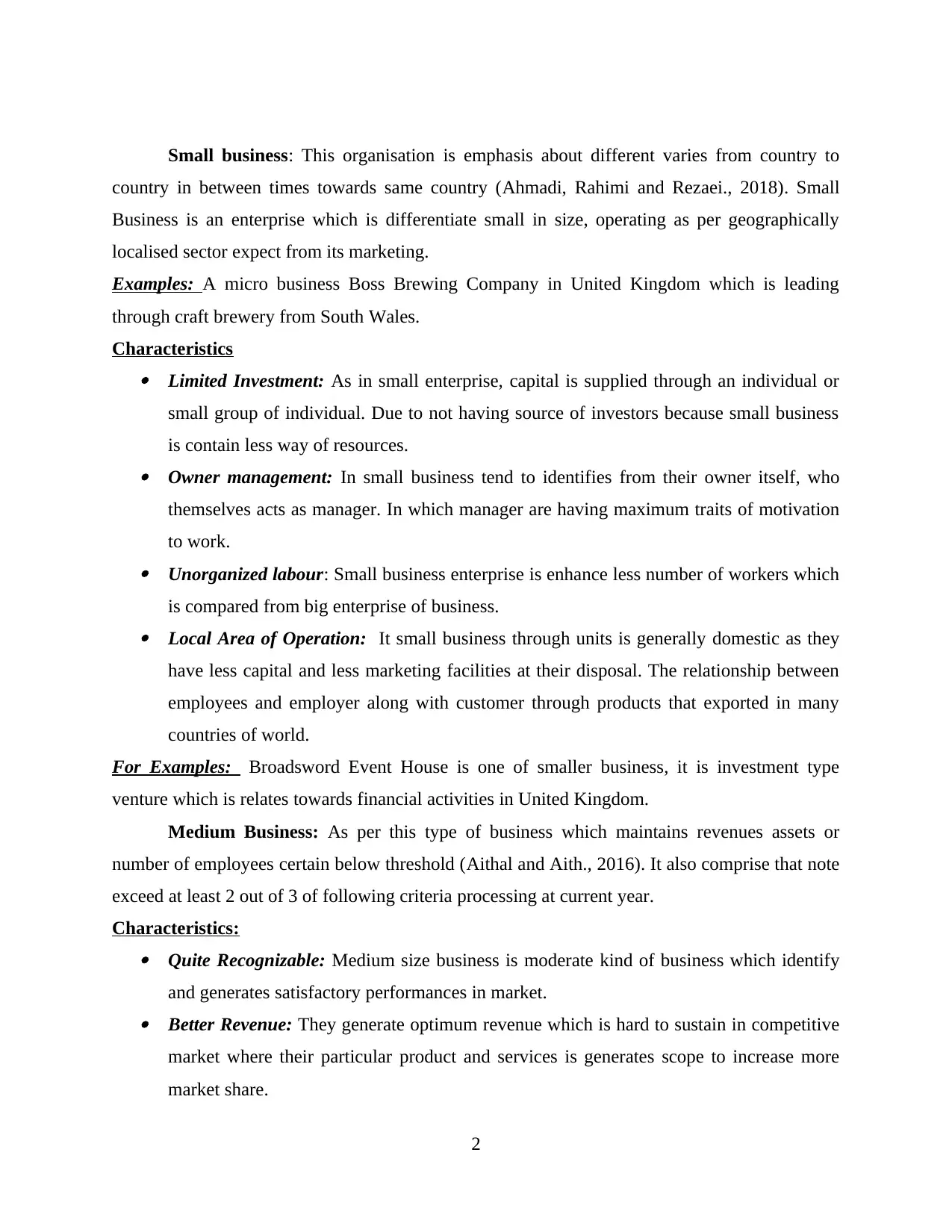
Small business: This organisation is emphasis about different varies from country to
country in between times towards same country (Ahmadi, Rahimi and Rezaei., 2018). Small
Business is an enterprise which is differentiate small in size, operating as per geographically
localised sector expect from its marketing.
Examples: A micro business Boss Brewing Company in United Kingdom which is leading
through craft brewery from South Wales.
Characteristics Limited Investment: As in small enterprise, capital is supplied through an individual or
small group of individual. Due to not having source of investors because small business
is contain less way of resources. Owner management: In small business tend to identifies from their owner itself, who
themselves acts as manager. In which manager are having maximum traits of motivation
to work. Unorganized labour: Small business enterprise is enhance less number of workers which
is compared from big enterprise of business. Local Area of Operation: It small business through units is generally domestic as they
have less capital and less marketing facilities at their disposal. The relationship between
employees and employer along with customer through products that exported in many
countries of world.
For Examples: Broadsword Event House is one of smaller business, it is investment type
venture which is relates towards financial activities in United Kingdom.
Medium Business: As per this type of business which maintains revenues assets or
number of employees certain below threshold (Aithal and Aith., 2016). It also comprise that note
exceed at least 2 out of 3 of following criteria processing at current year.
Characteristics: Quite Recognizable: Medium size business is moderate kind of business which identify
and generates satisfactory performances in market. Better Revenue: They generate optimum revenue which is hard to sustain in competitive
market where their particular product and services is generates scope to increase more
market share.
2
country in between times towards same country (Ahmadi, Rahimi and Rezaei., 2018). Small
Business is an enterprise which is differentiate small in size, operating as per geographically
localised sector expect from its marketing.
Examples: A micro business Boss Brewing Company in United Kingdom which is leading
through craft brewery from South Wales.
Characteristics Limited Investment: As in small enterprise, capital is supplied through an individual or
small group of individual. Due to not having source of investors because small business
is contain less way of resources. Owner management: In small business tend to identifies from their owner itself, who
themselves acts as manager. In which manager are having maximum traits of motivation
to work. Unorganized labour: Small business enterprise is enhance less number of workers which
is compared from big enterprise of business. Local Area of Operation: It small business through units is generally domestic as they
have less capital and less marketing facilities at their disposal. The relationship between
employees and employer along with customer through products that exported in many
countries of world.
For Examples: Broadsword Event House is one of smaller business, it is investment type
venture which is relates towards financial activities in United Kingdom.
Medium Business: As per this type of business which maintains revenues assets or
number of employees certain below threshold (Aithal and Aith., 2016). It also comprise that note
exceed at least 2 out of 3 of following criteria processing at current year.
Characteristics: Quite Recognizable: Medium size business is moderate kind of business which identify
and generates satisfactory performances in market. Better Revenue: They generate optimum revenue which is hard to sustain in competitive
market where their particular product and services is generates scope to increase more
market share.
2
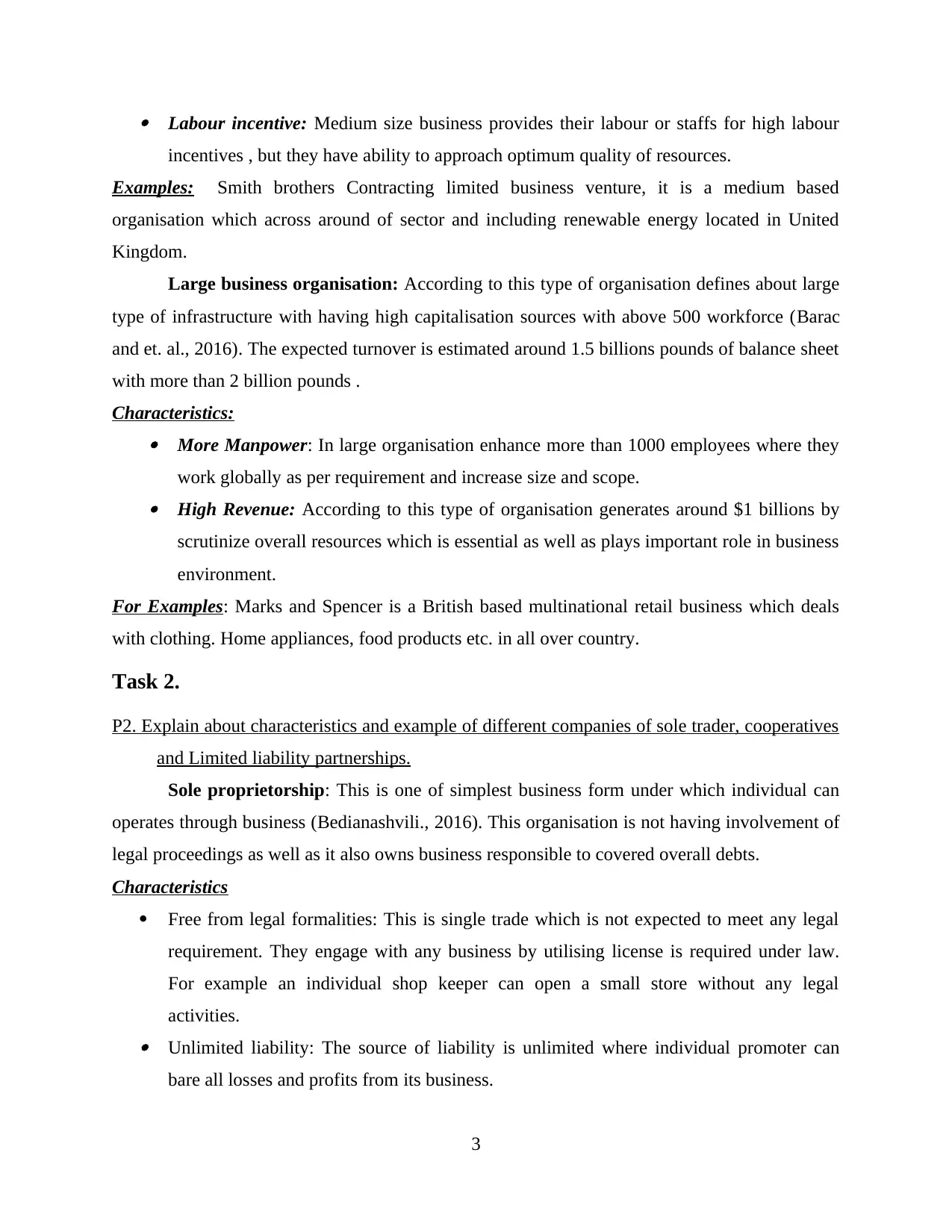
Labour incentive: Medium size business provides their labour or staffs for high labour
incentives , but they have ability to approach optimum quality of resources.
Examples: Smith brothers Contracting limited business venture, it is a medium based
organisation which across around of sector and including renewable energy located in United
Kingdom.
Large business organisation: According to this type of organisation defines about large
type of infrastructure with having high capitalisation sources with above 500 workforce (Barac
and et. al., 2016). The expected turnover is estimated around 1.5 billions pounds of balance sheet
with more than 2 billion pounds .
Characteristics: More Manpower: In large organisation enhance more than 1000 employees where they
work globally as per requirement and increase size and scope. High Revenue: According to this type of organisation generates around $1 billions by
scrutinize overall resources which is essential as well as plays important role in business
environment.
For Examples: Marks and Spencer is a British based multinational retail business which deals
with clothing. Home appliances, food products etc. in all over country.
Task 2.
P2. Explain about characteristics and example of different companies of sole trader, cooperatives
and Limited liability partnerships.
Sole proprietorship: This is one of simplest business form under which individual can
operates through business (Bedianashvili., 2016). This organisation is not having involvement of
legal proceedings as well as it also owns business responsible to covered overall debts.
Characteristics
Free from legal formalities: This is single trade which is not expected to meet any legal
requirement. They engage with any business by utilising license is required under law.
For example an individual shop keeper can open a small store without any legal
activities. Unlimited liability: The source of liability is unlimited where individual promoter can
bare all losses and profits from its business.
3
incentives , but they have ability to approach optimum quality of resources.
Examples: Smith brothers Contracting limited business venture, it is a medium based
organisation which across around of sector and including renewable energy located in United
Kingdom.
Large business organisation: According to this type of organisation defines about large
type of infrastructure with having high capitalisation sources with above 500 workforce (Barac
and et. al., 2016). The expected turnover is estimated around 1.5 billions pounds of balance sheet
with more than 2 billion pounds .
Characteristics: More Manpower: In large organisation enhance more than 1000 employees where they
work globally as per requirement and increase size and scope. High Revenue: According to this type of organisation generates around $1 billions by
scrutinize overall resources which is essential as well as plays important role in business
environment.
For Examples: Marks and Spencer is a British based multinational retail business which deals
with clothing. Home appliances, food products etc. in all over country.
Task 2.
P2. Explain about characteristics and example of different companies of sole trader, cooperatives
and Limited liability partnerships.
Sole proprietorship: This is one of simplest business form under which individual can
operates through business (Bedianashvili., 2016). This organisation is not having involvement of
legal proceedings as well as it also owns business responsible to covered overall debts.
Characteristics
Free from legal formalities: This is single trade which is not expected to meet any legal
requirement. They engage with any business by utilising license is required under law.
For example an individual shop keeper can open a small store without any legal
activities. Unlimited liability: The source of liability is unlimited where individual promoter can
bare all losses and profits from its business.
3
⊘ This is a preview!⊘
Do you want full access?
Subscribe today to unlock all pages.

Trusted by 1+ million students worldwide
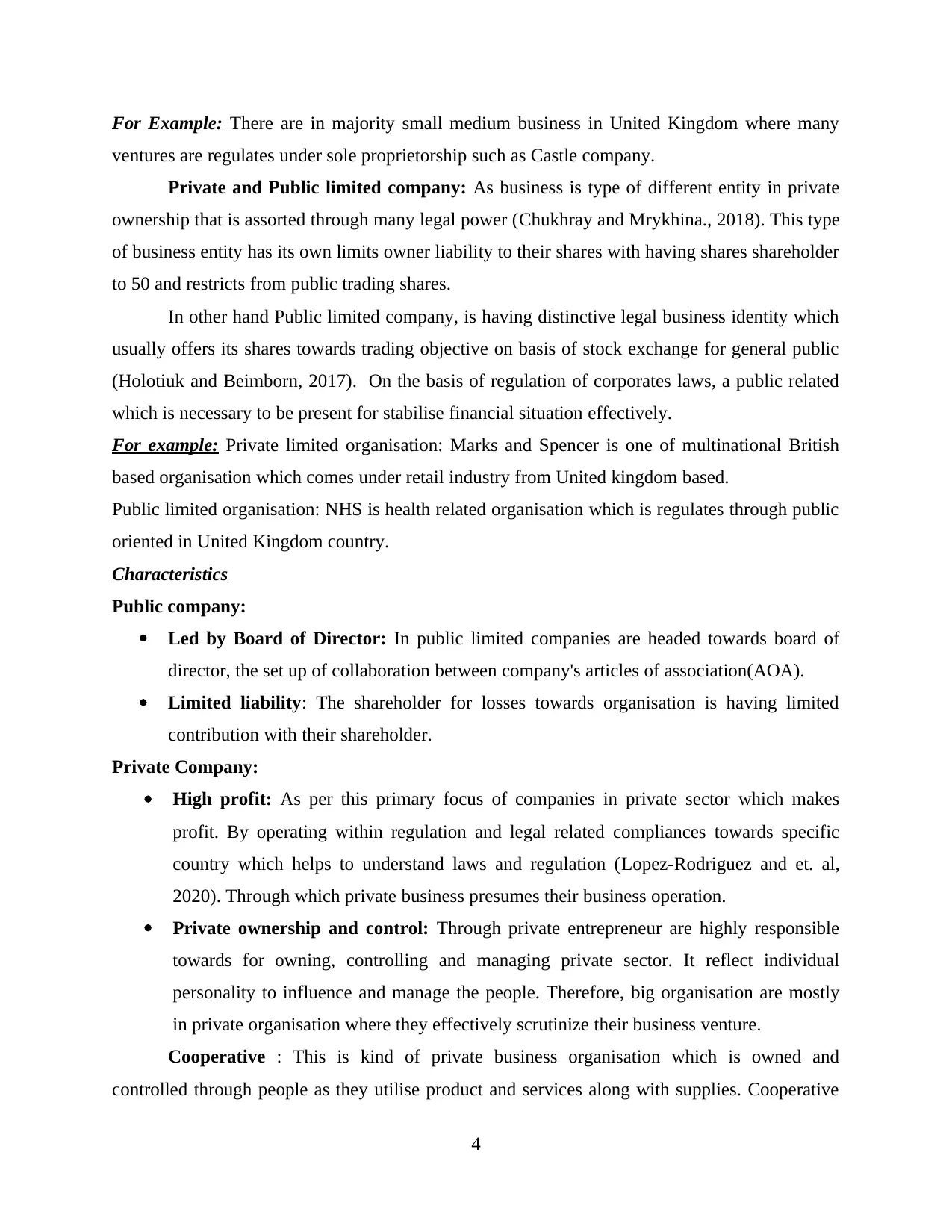
For Example: There are in majority small medium business in United Kingdom where many
ventures are regulates under sole proprietorship such as Castle company.
Private and Public limited company: As business is type of different entity in private
ownership that is assorted through many legal power (Chukhray and Mrykhina., 2018). This type
of business entity has its own limits owner liability to their shares with having shares shareholder
to 50 and restricts from public trading shares.
In other hand Public limited company, is having distinctive legal business identity which
usually offers its shares towards trading objective on basis of stock exchange for general public
(Holotiuk and Beimborn, 2017). On the basis of regulation of corporates laws, a public related
which is necessary to be present for stabilise financial situation effectively.
For example: Private limited organisation: Marks and Spencer is one of multinational British
based organisation which comes under retail industry from United kingdom based.
Public limited organisation: NHS is health related organisation which is regulates through public
oriented in United Kingdom country.
Characteristics
Public company:
Led by Board of Director: In public limited companies are headed towards board of
director, the set up of collaboration between company's articles of association(AOA).
Limited liability: The shareholder for losses towards organisation is having limited
contribution with their shareholder.
Private Company:
High profit: As per this primary focus of companies in private sector which makes
profit. By operating within regulation and legal related compliances towards specific
country which helps to understand laws and regulation (Lopez-Rodriguez and et. al,
2020). Through which private business presumes their business operation.
Private ownership and control: Through private entrepreneur are highly responsible
towards for owning, controlling and managing private sector. It reflect individual
personality to influence and manage the people. Therefore, big organisation are mostly
in private organisation where they effectively scrutinize their business venture.
Cooperative : This is kind of private business organisation which is owned and
controlled through people as they utilise product and services along with supplies. Cooperative
4
ventures are regulates under sole proprietorship such as Castle company.
Private and Public limited company: As business is type of different entity in private
ownership that is assorted through many legal power (Chukhray and Mrykhina., 2018). This type
of business entity has its own limits owner liability to their shares with having shares shareholder
to 50 and restricts from public trading shares.
In other hand Public limited company, is having distinctive legal business identity which
usually offers its shares towards trading objective on basis of stock exchange for general public
(Holotiuk and Beimborn, 2017). On the basis of regulation of corporates laws, a public related
which is necessary to be present for stabilise financial situation effectively.
For example: Private limited organisation: Marks and Spencer is one of multinational British
based organisation which comes under retail industry from United kingdom based.
Public limited organisation: NHS is health related organisation which is regulates through public
oriented in United Kingdom country.
Characteristics
Public company:
Led by Board of Director: In public limited companies are headed towards board of
director, the set up of collaboration between company's articles of association(AOA).
Limited liability: The shareholder for losses towards organisation is having limited
contribution with their shareholder.
Private Company:
High profit: As per this primary focus of companies in private sector which makes
profit. By operating within regulation and legal related compliances towards specific
country which helps to understand laws and regulation (Lopez-Rodriguez and et. al,
2020). Through which private business presumes their business operation.
Private ownership and control: Through private entrepreneur are highly responsible
towards for owning, controlling and managing private sector. It reflect individual
personality to influence and manage the people. Therefore, big organisation are mostly
in private organisation where they effectively scrutinize their business venture.
Cooperative : This is kind of private business organisation which is owned and
controlled through people as they utilise product and services along with supplies. Cooperative
4
Paraphrase This Document
Need a fresh take? Get an instant paraphrase of this document with our AI Paraphraser
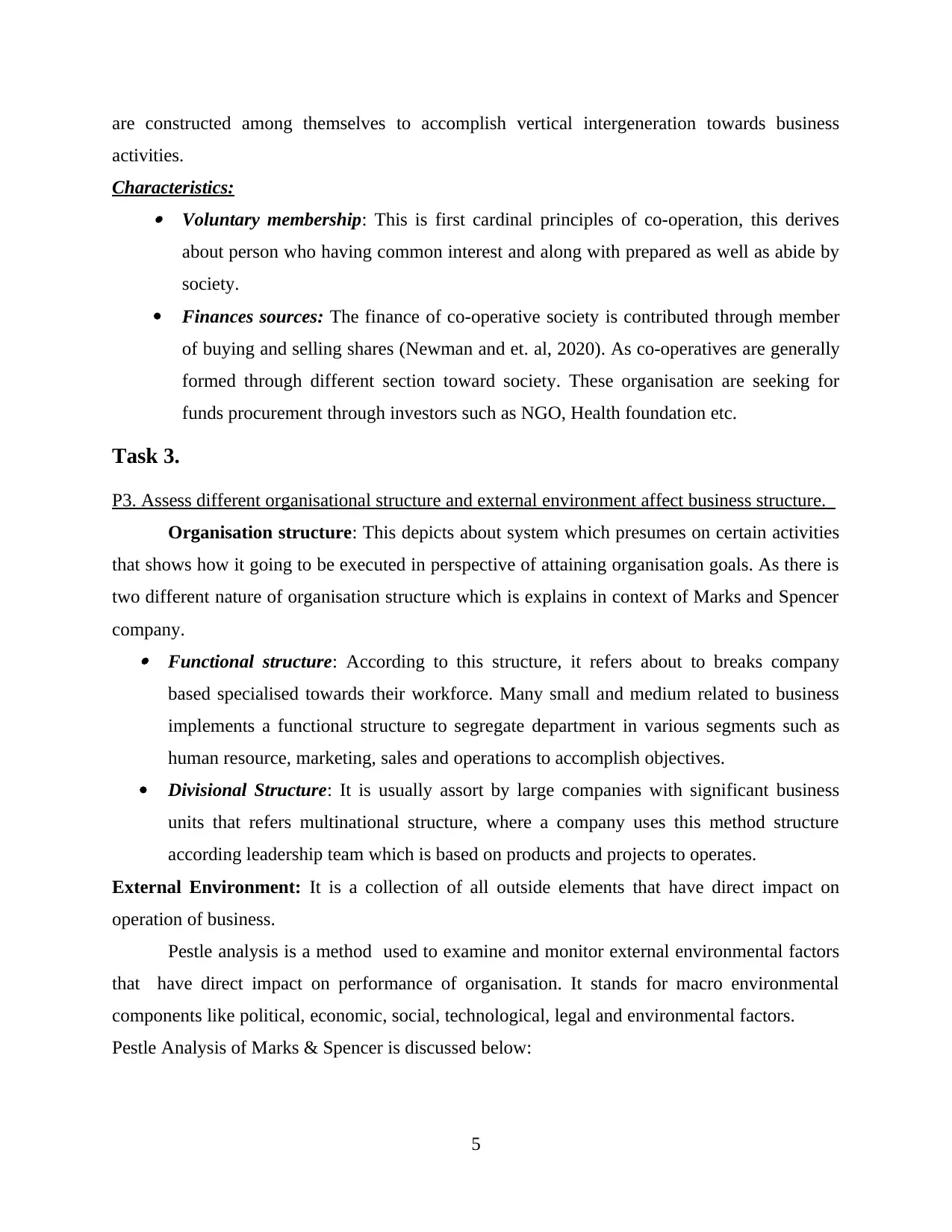
are constructed among themselves to accomplish vertical intergeneration towards business
activities.
Characteristics: Voluntary membership: This is first cardinal principles of co-operation, this derives
about person who having common interest and along with prepared as well as abide by
society.
Finances sources: The finance of co-operative society is contributed through member
of buying and selling shares (Newman and et. al, 2020). As co-operatives are generally
formed through different section toward society. These organisation are seeking for
funds procurement through investors such as NGO, Health foundation etc.
Task 3.
P3. Assess different organisational structure and external environment affect business structure.
Organisation structure: This depicts about system which presumes on certain activities
that shows how it going to be executed in perspective of attaining organisation goals. As there is
two different nature of organisation structure which is explains in context of Marks and Spencer
company. Functional structure: According to this structure, it refers about to breaks company
based specialised towards their workforce. Many small and medium related to business
implements a functional structure to segregate department in various segments such as
human resource, marketing, sales and operations to accomplish objectives.
Divisional Structure: It is usually assort by large companies with significant business
units that refers multinational structure, where a company uses this method structure
according leadership team which is based on products and projects to operates.
External Environment: It is a collection of all outside elements that have direct impact on
operation of business.
Pestle analysis is a method used to examine and monitor external environmental factors
that have direct impact on performance of organisation. It stands for macro environmental
components like political, economic, social, technological, legal and environmental factors.
Pestle Analysis of Marks & Spencer is discussed below:
5
activities.
Characteristics: Voluntary membership: This is first cardinal principles of co-operation, this derives
about person who having common interest and along with prepared as well as abide by
society.
Finances sources: The finance of co-operative society is contributed through member
of buying and selling shares (Newman and et. al, 2020). As co-operatives are generally
formed through different section toward society. These organisation are seeking for
funds procurement through investors such as NGO, Health foundation etc.
Task 3.
P3. Assess different organisational structure and external environment affect business structure.
Organisation structure: This depicts about system which presumes on certain activities
that shows how it going to be executed in perspective of attaining organisation goals. As there is
two different nature of organisation structure which is explains in context of Marks and Spencer
company. Functional structure: According to this structure, it refers about to breaks company
based specialised towards their workforce. Many small and medium related to business
implements a functional structure to segregate department in various segments such as
human resource, marketing, sales and operations to accomplish objectives.
Divisional Structure: It is usually assort by large companies with significant business
units that refers multinational structure, where a company uses this method structure
according leadership team which is based on products and projects to operates.
External Environment: It is a collection of all outside elements that have direct impact on
operation of business.
Pestle analysis is a method used to examine and monitor external environmental factors
that have direct impact on performance of organisation. It stands for macro environmental
components like political, economic, social, technological, legal and environmental factors.
Pestle Analysis of Marks & Spencer is discussed below:
5
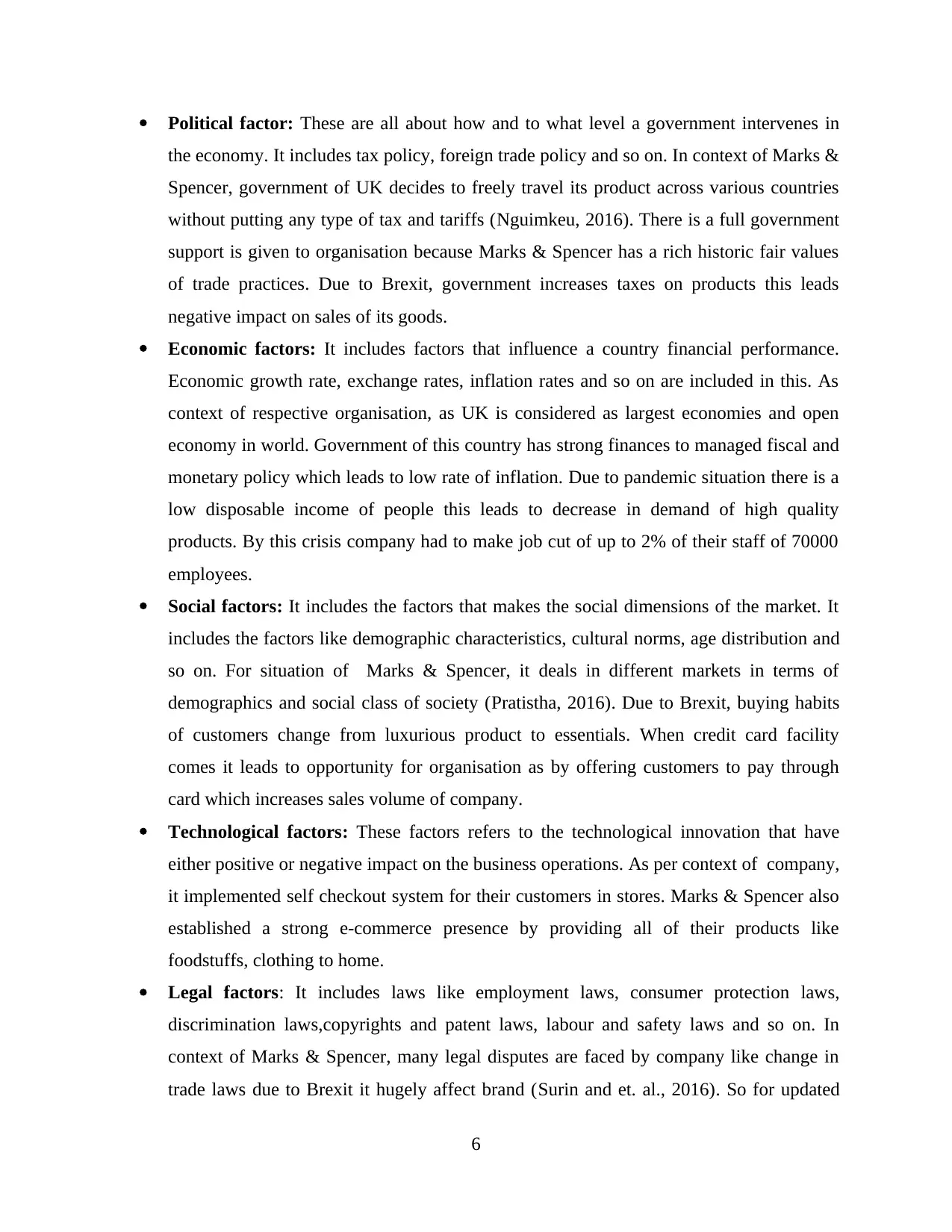
Political factor: These are all about how and to what level a government intervenes in
the economy. It includes tax policy, foreign trade policy and so on. In context of Marks &
Spencer, government of UK decides to freely travel its product across various countries
without putting any type of tax and tariffs (Nguimkeu, 2016). There is a full government
support is given to organisation because Marks & Spencer has a rich historic fair values
of trade practices. Due to Brexit, government increases taxes on products this leads
negative impact on sales of its goods.
Economic factors: It includes factors that influence a country financial performance.
Economic growth rate, exchange rates, inflation rates and so on are included in this. As
context of respective organisation, as UK is considered as largest economies and open
economy in world. Government of this country has strong finances to managed fiscal and
monetary policy which leads to low rate of inflation. Due to pandemic situation there is a
low disposable income of people this leads to decrease in demand of high quality
products. By this crisis company had to make job cut of up to 2% of their staff of 70000
employees.
Social factors: It includes the factors that makes the social dimensions of the market. It
includes the factors like demographic characteristics, cultural norms, age distribution and
so on. For situation of Marks & Spencer, it deals in different markets in terms of
demographics and social class of society (Pratistha, 2016). Due to Brexit, buying habits
of customers change from luxurious product to essentials. When credit card facility
comes it leads to opportunity for organisation as by offering customers to pay through
card which increases sales volume of company.
Technological factors: These factors refers to the technological innovation that have
either positive or negative impact on the business operations. As per context of company,
it implemented self checkout system for their customers in stores. Marks & Spencer also
established a strong e-commerce presence by providing all of their products like
foodstuffs, clothing to home.
Legal factors: It includes laws like employment laws, consumer protection laws,
discrimination laws,copyrights and patent laws, labour and safety laws and so on. In
context of Marks & Spencer, many legal disputes are faced by company like change in
trade laws due to Brexit it hugely affect brand (Surin and et. al., 2016). So for updated
6
the economy. It includes tax policy, foreign trade policy and so on. In context of Marks &
Spencer, government of UK decides to freely travel its product across various countries
without putting any type of tax and tariffs (Nguimkeu, 2016). There is a full government
support is given to organisation because Marks & Spencer has a rich historic fair values
of trade practices. Due to Brexit, government increases taxes on products this leads
negative impact on sales of its goods.
Economic factors: It includes factors that influence a country financial performance.
Economic growth rate, exchange rates, inflation rates and so on are included in this. As
context of respective organisation, as UK is considered as largest economies and open
economy in world. Government of this country has strong finances to managed fiscal and
monetary policy which leads to low rate of inflation. Due to pandemic situation there is a
low disposable income of people this leads to decrease in demand of high quality
products. By this crisis company had to make job cut of up to 2% of their staff of 70000
employees.
Social factors: It includes the factors that makes the social dimensions of the market. It
includes the factors like demographic characteristics, cultural norms, age distribution and
so on. For situation of Marks & Spencer, it deals in different markets in terms of
demographics and social class of society (Pratistha, 2016). Due to Brexit, buying habits
of customers change from luxurious product to essentials. When credit card facility
comes it leads to opportunity for organisation as by offering customers to pay through
card which increases sales volume of company.
Technological factors: These factors refers to the technological innovation that have
either positive or negative impact on the business operations. As per context of company,
it implemented self checkout system for their customers in stores. Marks & Spencer also
established a strong e-commerce presence by providing all of their products like
foodstuffs, clothing to home.
Legal factors: It includes laws like employment laws, consumer protection laws,
discrimination laws,copyrights and patent laws, labour and safety laws and so on. In
context of Marks & Spencer, many legal disputes are faced by company like change in
trade laws due to Brexit it hugely affect brand (Surin and et. al., 2016). So for updated
6
⊘ This is a preview!⊘
Do you want full access?
Subscribe today to unlock all pages.

Trusted by 1+ million students worldwide
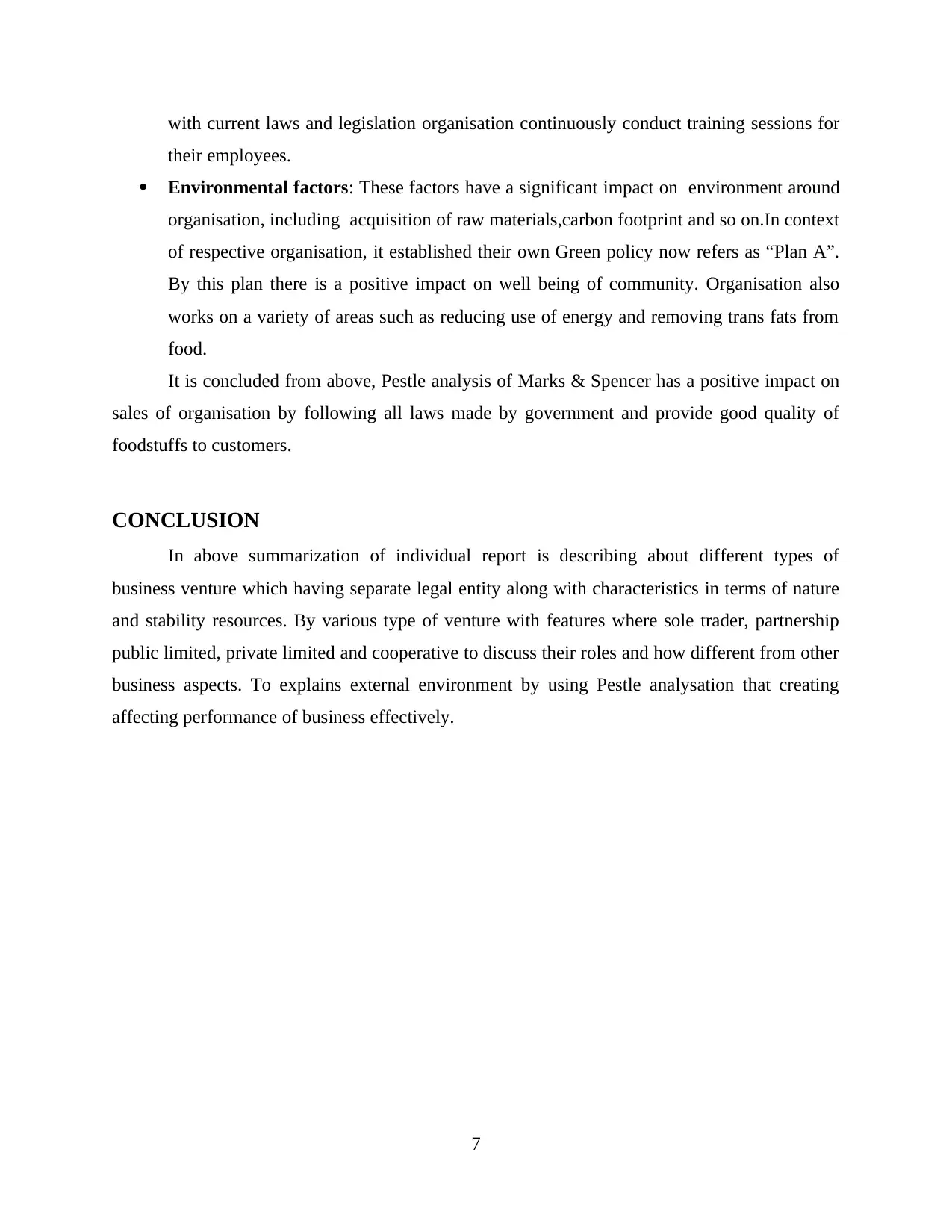
with current laws and legislation organisation continuously conduct training sessions for
their employees.
Environmental factors: These factors have a significant impact on environment around
organisation, including acquisition of raw materials,carbon footprint and so on.In context
of respective organisation, it established their own Green policy now refers as “Plan A”.
By this plan there is a positive impact on well being of community. Organisation also
works on a variety of areas such as reducing use of energy and removing trans fats from
food.
It is concluded from above, Pestle analysis of Marks & Spencer has a positive impact on
sales of organisation by following all laws made by government and provide good quality of
foodstuffs to customers.
CONCLUSION
In above summarization of individual report is describing about different types of
business venture which having separate legal entity along with characteristics in terms of nature
and stability resources. By various type of venture with features where sole trader, partnership
public limited, private limited and cooperative to discuss their roles and how different from other
business aspects. To explains external environment by using Pestle analysation that creating
affecting performance of business effectively.
7
their employees.
Environmental factors: These factors have a significant impact on environment around
organisation, including acquisition of raw materials,carbon footprint and so on.In context
of respective organisation, it established their own Green policy now refers as “Plan A”.
By this plan there is a positive impact on well being of community. Organisation also
works on a variety of areas such as reducing use of energy and removing trans fats from
food.
It is concluded from above, Pestle analysis of Marks & Spencer has a positive impact on
sales of organisation by following all laws made by government and provide good quality of
foodstuffs to customers.
CONCLUSION
In above summarization of individual report is describing about different types of
business venture which having separate legal entity along with characteristics in terms of nature
and stability resources. By various type of venture with features where sole trader, partnership
public limited, private limited and cooperative to discuss their roles and how different from other
business aspects. To explains external environment by using Pestle analysation that creating
affecting performance of business effectively.
7
Paraphrase This Document
Need a fresh take? Get an instant paraphrase of this document with our AI Paraphraser
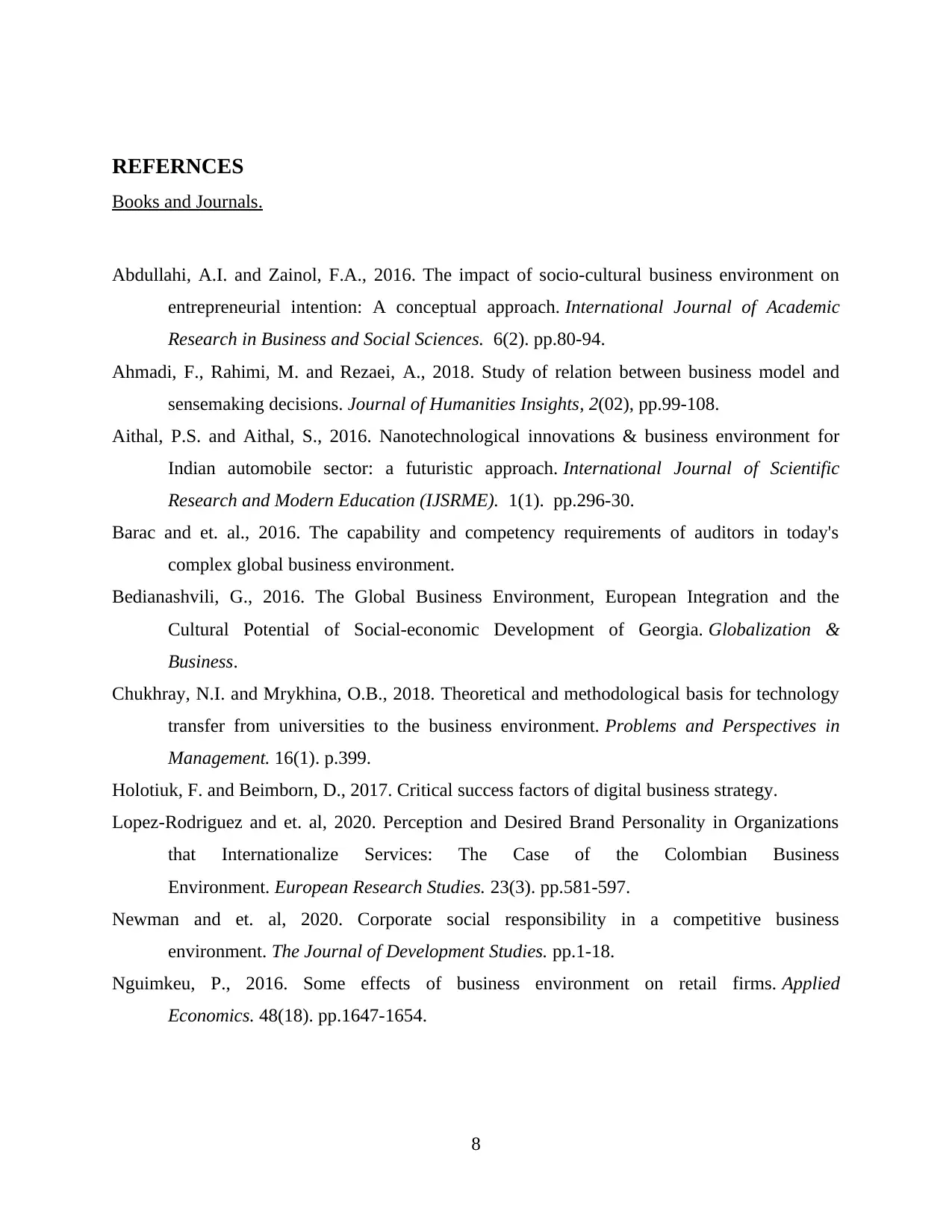
REFERNCES
Books and Journals.
Abdullahi, A.I. and Zainol, F.A., 2016. The impact of socio-cultural business environment on
entrepreneurial intention: A conceptual approach. International Journal of Academic
Research in Business and Social Sciences. 6(2). pp.80-94.
Ahmadi, F., Rahimi, M. and Rezaei, A., 2018. Study of relation between business model and
sensemaking decisions. Journal of Humanities Insights, 2(02), pp.99-108.
Aithal, P.S. and Aithal, S., 2016. Nanotechnological innovations & business environment for
Indian automobile sector: a futuristic approach. International Journal of Scientific
Research and Modern Education (IJSRME). 1(1). pp.296-30.
Barac and et. al., 2016. The capability and competency requirements of auditors in today's
complex global business environment.
Bedianashvili, G., 2016. The Global Business Environment, European Integration and the
Cultural Potential of Social-economic Development of Georgia. Globalization &
Business.
Chukhray, N.I. and Mrykhina, O.B., 2018. Theoretical and methodological basis for technology
transfer from universities to the business environment. Problems and Perspectives in
Management. 16(1). p.399.
Holotiuk, F. and Beimborn, D., 2017. Critical success factors of digital business strategy.
Lopez-Rodriguez and et. al, 2020. Perception and Desired Brand Personality in Organizations
that Internationalize Services: The Case of the Colombian Business
Environment. European Research Studies. 23(3). pp.581-597.
Newman and et. al, 2020. Corporate social responsibility in a competitive business
environment. The Journal of Development Studies. pp.1-18.
Nguimkeu, P., 2016. Some effects of business environment on retail firms. Applied
Economics. 48(18). pp.1647-1654.
8
Books and Journals.
Abdullahi, A.I. and Zainol, F.A., 2016. The impact of socio-cultural business environment on
entrepreneurial intention: A conceptual approach. International Journal of Academic
Research in Business and Social Sciences. 6(2). pp.80-94.
Ahmadi, F., Rahimi, M. and Rezaei, A., 2018. Study of relation between business model and
sensemaking decisions. Journal of Humanities Insights, 2(02), pp.99-108.
Aithal, P.S. and Aithal, S., 2016. Nanotechnological innovations & business environment for
Indian automobile sector: a futuristic approach. International Journal of Scientific
Research and Modern Education (IJSRME). 1(1). pp.296-30.
Barac and et. al., 2016. The capability and competency requirements of auditors in today's
complex global business environment.
Bedianashvili, G., 2016. The Global Business Environment, European Integration and the
Cultural Potential of Social-economic Development of Georgia. Globalization &
Business.
Chukhray, N.I. and Mrykhina, O.B., 2018. Theoretical and methodological basis for technology
transfer from universities to the business environment. Problems and Perspectives in
Management. 16(1). p.399.
Holotiuk, F. and Beimborn, D., 2017. Critical success factors of digital business strategy.
Lopez-Rodriguez and et. al, 2020. Perception and Desired Brand Personality in Organizations
that Internationalize Services: The Case of the Colombian Business
Environment. European Research Studies. 23(3). pp.581-597.
Newman and et. al, 2020. Corporate social responsibility in a competitive business
environment. The Journal of Development Studies. pp.1-18.
Nguimkeu, P., 2016. Some effects of business environment on retail firms. Applied
Economics. 48(18). pp.1647-1654.
8
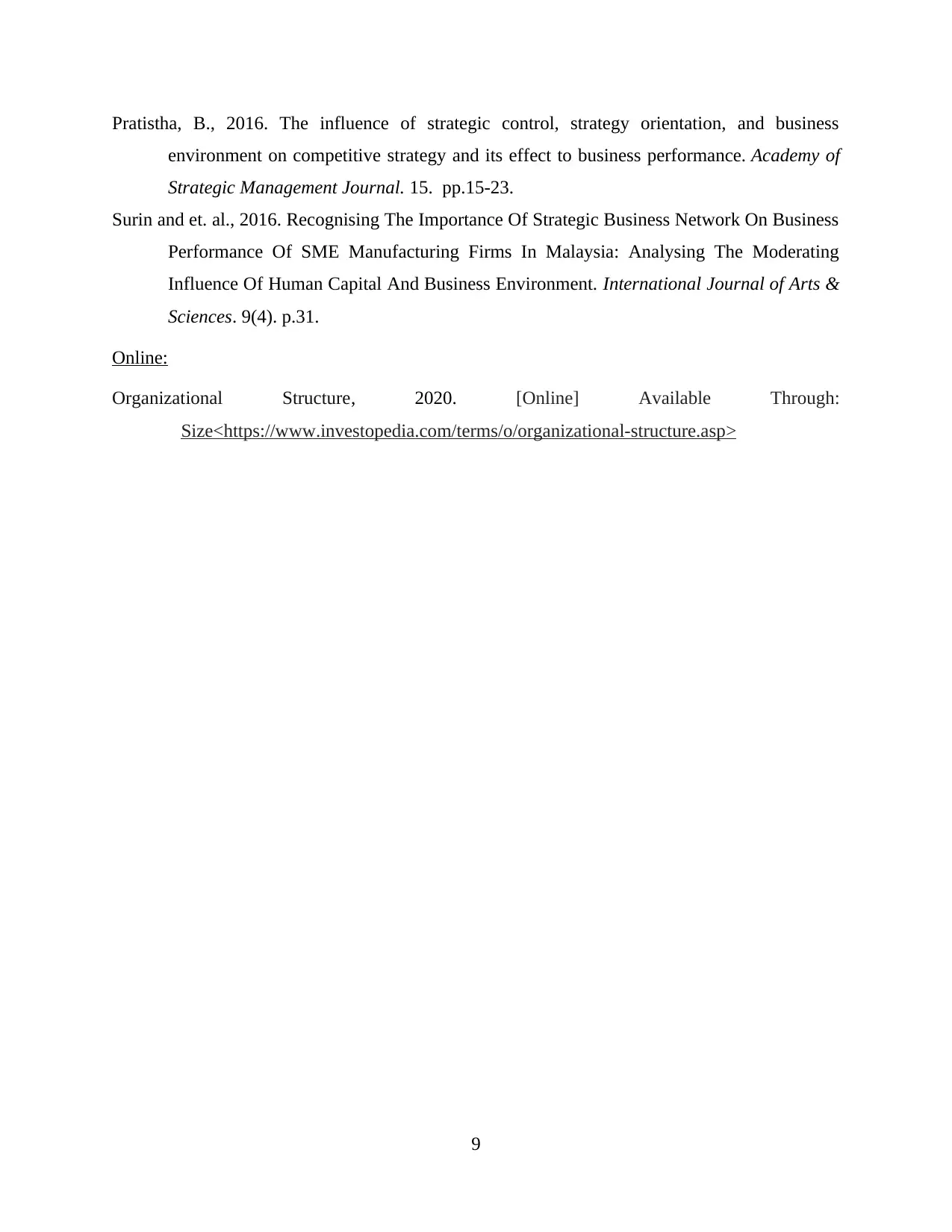
Pratistha, B., 2016. The influence of strategic control, strategy orientation, and business
environment on competitive strategy and its effect to business performance. Academy of
Strategic Management Journal. 15. pp.15-23.
Surin and et. al., 2016. Recognising The Importance Of Strategic Business Network On Business
Performance Of SME Manufacturing Firms In Malaysia: Analysing The Moderating
Influence Of Human Capital And Business Environment. International Journal of Arts &
Sciences. 9(4). p.31.
Online:
Organizational Structure, 2020. [Online] Available Through:
Size<https://www.investopedia.com/terms/o/organizational-structure.asp>
9
environment on competitive strategy and its effect to business performance. Academy of
Strategic Management Journal. 15. pp.15-23.
Surin and et. al., 2016. Recognising The Importance Of Strategic Business Network On Business
Performance Of SME Manufacturing Firms In Malaysia: Analysing The Moderating
Influence Of Human Capital And Business Environment. International Journal of Arts &
Sciences. 9(4). p.31.
Online:
Organizational Structure, 2020. [Online] Available Through:
Size<https://www.investopedia.com/terms/o/organizational-structure.asp>
9
⊘ This is a preview!⊘
Do you want full access?
Subscribe today to unlock all pages.

Trusted by 1+ million students worldwide
1 out of 12
Related Documents
Your All-in-One AI-Powered Toolkit for Academic Success.
+13062052269
info@desklib.com
Available 24*7 on WhatsApp / Email
![[object Object]](/_next/static/media/star-bottom.7253800d.svg)
Unlock your academic potential
Copyright © 2020–2025 A2Z Services. All Rights Reserved. Developed and managed by ZUCOL.





